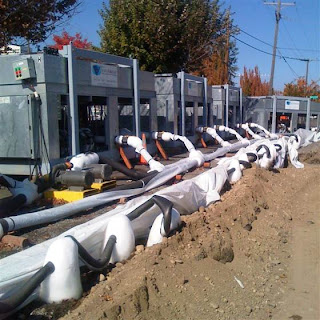 |
| SoilFreeze's chillers and brine lines connected to the refrigerator pipes are lined up at a remediation site in Tacoma, Wash. |
The plan calls for burying refrigeration pipes to a depth of 100 feet, every yard or so, for almost a mile around the radioactive site. Those pipes would freeze the ground to keep water from flowing in or out — and any new water that comes in contact with it would freeze as well, making the wall even stronger. The job is scheduled to take 18 months, but once the barrier is fully in place, 10 feet of ice would seal off Fukushima's contaminated soil.
Ice-barrier technology has been used at conventional construction sites for decades. It’s even been demonstrated at Oak Ridge National Laboratory in Tennessee, the only place in the world to date where such a barrier was built to contain radioactive waste. A $1 million ice-barrier project at Oak Ridge was put into place in 1997 to demonstrate that the technology could be used to contain radioactive waste. But the technology has never been used on a problem as big as Fukushima. The Fukushima would be 150 times bigger.
Ironically, one of the biggest potential challenges for sealing off the defunct Fukushima power facility is the enormous electrical demand: Experts estimate that it would take several megawatts of electricity to create and then maintain the ice shield, and the ruined reactors aren’t an option.
The power plant’s operator — the Tokyo Electric Power Co., or TEPCO — has been considering the ice-barrier plan among other options for remediation, in the wake of the 2011 earthquake and tsunami that wrecked the plant and spread radioactive contamination. Fresh readings, indicating that hundreds of tons of radioactive water were still leaking from the site, added to the urgency.
On Tuesday, the Japanese government said it was stepping in. "Instead of leaving this up to TEPCO, the government will step forward and take charge," Prime Minister Shinzo Abe said at a Tokyo news conference. "The world is watching if we can properly handle the contaminated water, but also the entire decommissioning of the plant."
The government is setting aside $320 million for the ice barrier, and another $150 million for upgraded water treatment facilities. Kajima Corp., the same company that built the Fukushima Daiichi plant, is conducting feasibility studies for the barrier and would put it in place by March 2015.
The engineering challenges start at the very beginning: The hard part on this job is keeping your people safe while doing the work, and not spreading the contamination.
The project would involve installing liquid-cooled pipe systems into each of the 100-foot-deep holes to freeze the earth in a tight 0.9-mile perimeter around the four white buildings that house the nuclear reactors. The liquid, which could be brine or a type of antifreeze, would be cooled to -5 to -40 degrees Fahrenheit. Over the course of a year, the intervening ground would freeze solid, all the way down to the layer of low-permeability clay and rock beneath the Fukushima Daiichi plant.
Theoretically, there are other ways to seal off the site from groundwater — for example, by digging huge trenches and filling them with clay or concrete. But the self-healing quality of an ice barrier is a big plus. Groundwater coming in from the surrounding area just freezes into place at the barrier. The same goes for any contaminated water leaking from the tanks. Even if the power to the refrigeration units was cut, the ice would hold for weeks or months.
The power requirements would be substantial — equivalent to the electricity used by thousands of households. But that's not seen as a deal-breaker.
Seattle-based SoilFreeze, which also played a part in the Oak Ridge demonstration and holds several patents for frozen-earth barriers.
The Oak Ridge barrier was designed to last for 15 years, but it was dismantled after six years when power plant managers decided to move forward with a different soil remediation project. When they turned the wall off, a year later it was still frozen.
How long would the Fukushima barrier have to hold? Japan has set a 40-year timeline for decommissioning and cleanup at Fukushima. Ice-barrier technology has not been proven to last that long. TEPCO and the Japanese government will still need a few layers of safety backups in case it fails.
In any case, the ice barrier is seen a temporary fix. Yarmak says future technologies — say, new materials for construction barriers, or new soil remediation methods — may provide fresh options for the Japanese in the years ahead. (NBC News, 9/2/2013)
No comments:
Post a Comment